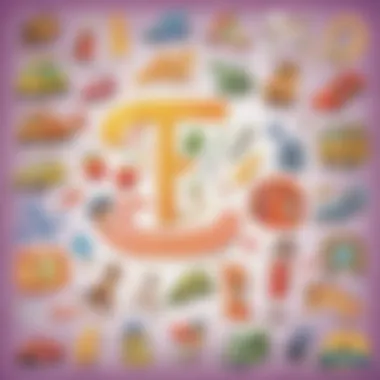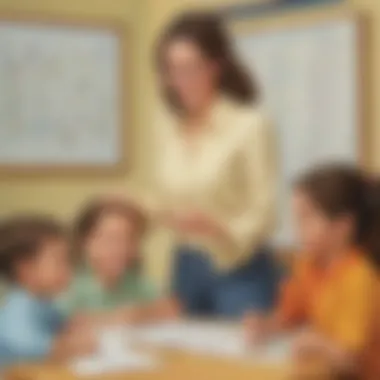Exploring Letter E: Preschool Vocabulary Guide


Intro
Building a strong vocabulary lays the foundation for literacy in preschool-aged children. The letter 'E' offers a delightful range of words that can stimulate a child’s interest and engagement in learning. Recognizing this importance, the focus of this guide is to explore various words starting with the letter 'E' and provide a framework for teaching them effectively. Educators and parents can find diverse strategies, creative activities, and quizzes that will enhance early literacy skills while keeping children engaged.
By systemically integrating these words into daily activities and conversations, adults can nurture a vibrant learning environment. The following sections will delve into engaging creative activities, fun quizzes for knowledge reinforcement, and interesting fact-based articles. Each aspect is designed to promote a comprehensive understanding of vocabulary related to the letter 'E'.
Creative Activities
Engaging children through hands-on activities is crucial for effective learning. Activities focusing on vocabulary not only reinforce words but also spark creativity and curiosity. Here are a few suggestions that can help.
Craft Ideas
Craft ideas for the letter 'E' include creating elephant masks, egg shells decorations, or envelopes decorated with stickers. These activities allow children to express themselves creatively while learning new words. For example, making an elephant mask introduces the animal while the craft itself becomes an unforgettable experience.
Step-by-Step Guides
- Elephant Mask Craft
- Egg Shell Decorations
- Materials: Paper plates, scissors, crayons, and elastic bands.
- Instructions: Cut out the center of a paper plate, then use another paper plate to create ears. Color the mask with crayons and attach the elastic band.
- Materials: Egg shells, paint, glue, and paper.
- Instructions: After emptying and cleaning the egg shells, paint them in various colors. Glue them onto the paper to create a vibrant collage.
Educational Value
These creative activities provide several educational benefits. They encourage fine motor skills, enhance cognitive development, and reinforce vocabulary. When a child creates something, they feel accomplished, which boosts their confidence. Engaging in discussions about the words while crafting further solidifies the learning experience.
Fun Quizzes
Quizzes can be an exciting way to reinforce knowledge learned from vocabulary activities. They serve as tools for assessment and review. A variety of quiz topics can enhance learning while maintaining interest.
Quiz Topics
Quizzes focusing on the following topics can be beneficial:
- Animals that start with 'E', like elephants and eagles.
- Everyday items starting with 'E', such as eggs and envelopes.
- Emotions and feelings featuring words like excited and embarrassed.
Question Types
Incorporating various question types keeps quizzes engaging:
- Multiple-choice questions.
- Fill-in-the-blank statements.
- Picture identification for associated words.
Knowledge Reinforcement
Such quizzes not only enhance vocabulary recall but also enable children to learn in a fun way. They provide immediate feedback, allowing caregivers to identify areas needing improvement. Whether conducted verbally or through colorful worksheets, quizzes can effectively reinforce learning.
Fact-Based Articles
Fact-based articles on topics relevant to preschool vocabulary can further enhance understanding. These articles can present complex concepts in simple, comprehensible ways.
Topics
The articles can cover various themes:
- Nature, focusing on ecosystems and different elements like earth and energy.
- Animals, emphasizing living creatures like the elephant and eel.
- Emotions that help children understand feelings and their expressions.
Engaging Content
Well-structured articles employ straightforward language and interesting facts that keep young readers engaged. Pictures can accompany the text for visual stimulation, enhancing children’s interest and comprehension.
Foreword to the Letter E


Understanding the letter E is crucial for preschoolers. This letter is one of the most commonly used in the English language. Early recognition of its sound, shape, and usage prepares children for more complex literacy tasks in the future. Learning about the letter E introduces children to a list of relevant vocabulary. This makes it easier for them to understand the world around them.
Significance of Learning Letter E
Learning the letter E has several important benefits. It fosters communication skills by encouraging children to express themselves using new words. The number of words that start with E is significant, including everyday items and actions. When children learn these words, they expand their vocabulary, which enhances their ability to communicate effectively.
Moreover, mastering the letter E provides a foundation for phonics. Phonics is the relationship between sounds and letters. Recognizing the letter E and its sounds aids children in reading and pronunciation. This is essential for building confidence in their language skills. Hence, introducing this letter and its corresponding words during preschool can lead to better literacy outcomes.
Overview of Preschool Vocabulary
Preschool vocabulary is a collection of words that children should learn before they begin formal reading. It includes a range of words that describe their environment, experiences, and emotions.
For children, learning vocabulary connects to communication and comprehension. It helps them navigate conversations and understand others better.
A well-rounded vocabulary not only supports general knowledge but also fosters social and emotional skills. Children who develop a strong vocabulary express their thoughts and feelings, which in turn builds their confidence. Incorporating words that start with E into preschool activities creates a more engaging language-learning experience. This focus on essential vocabulary also prepares them for future academic challenges.
Common Words Starting with E
Understanding common words that start with the letter E is essential in building preschool vocabulary. These foundational words assist children in expanding their linguistic skills in everyday contexts. By focusing on diverse categories, such as nouns and verbs, parents and educators can provide a comprehensive learning experience. Such vocabulary aids in enhancing children's comprehension and communication abilities.
Everyday Nouns
Egg
The word "Egg" refers to a potent food source found in many cuisines. Eggs are versatile in cooking and can be both delicious and nutritious. Its simplicity makes it a beneficial choice for preschoolers. Teaching the word "Egg" introduces children to concepts like breakfast and different types of food. Moreover, eggs come in various colors and shapes, which adds an interesting visual aspect for young learners. On the downside, some kids may have allergies to eggs, which might limit discussions around this word.
Elephant
The "Elephant" is a large, intelligent animal. Adding this word to a child's vocabulary helps in introducing them to wildlife and nature. Its distinct features, like big ears and a trunk, make it an engaging subject for storytelling. The uniqueness of elephants allows discussions about their habitats and conservation. However, the size and complexity of elephants may confuse some children when first learning about them.
Envelope
An "Envelope" is commonly used to hold letters. This word helps children understand communication tools in everyday life. The variety of colors and sizes of envelopes can stimulate discussions about mail and sending messages. Envelopes provide a tangible way to explore concepts like letters, friendship, and sharing. A potential drawback could be that young learners may not frequently interact with envelopes, making it a less relatable term.
Engine
The term "Engine" refers to the mechanical device that powers vehicles. Learning this word can spark curiosity about how things work in our environment. It is crucial in discussions surrounding transportation and technology. The relationship between engines and various types of vehicles introduces concepts of movement and energy. Nevertheless, some children may struggle to grasp its technical nature, leading to confusion regarding its meaning and application.
Verbs and Actions
Eat
The verb "Eat" is fundamental in understanding one of the most basic human actions. It defines a daily necessity that every child can relate to, making it a highly beneficial word. By teaching this verb, children learn about food and nutrition. It also opens the door for conversations about healthy eating habits. However, some children might express differing preferences for food, which could lead to varying interpretations of the term.
Echo
The word "Echo" signifies a sound that reflects back. This term can engage preschoolers' senses and spark an interest in sound exploration. Learning about echoes allows children to understand sound waves and their behavior, cultivating curiosity about nature. While neat, the concept may require a visual demonstration, which could be challenging without proper context for some learners.
Explore
The verb "Explore" embodies curiosity and adventure. It encourages preschoolers to discover their environment. This action word can inspire imaginative play and sensory activities. Teaching this word can contribute to the development of problem-solving skills. However, some children may require guidance to understand the abstract notion of exploration, making it a bit challenging without explicit examples.
Categorizing Letter E Words
Understanding how to categorize words starting with the letter E is crucial for preschool vocabulary development. Categorization promotes cognitive organization in young learners. It helps them group similar concepts, making it easier to recall and use these words. Furthermore, categorizing words by themes, such as animals or food, enhances contextual understanding and makes learning more engaging. Children can relate words to specific themes in their lives, which aids comprehension. This section will explore various categories of E words, focusing on Animals and Nature, as well as Food and Drinks.
Animals and Nature
In preschool, learning about animals helps children connect with the natural world. It also introduces them to vocabulary they might encounter while outside or in books. By focusing on animals, children can develop curiosity about their environments.
Eagle
The Eagle is a magnificent bird. Known for its sharp vision, it can spot prey from a great distance. Eagles often symbolize strength and freedom. This makes them a popular choice in discussions about wildlife. Teaching preschoolers about the Eagle can help them understand basic concepts in nature, such as habitats and food chains. However, it is essential to explain that eagles are not commonly found everywhere. This could present a challenge in teaching them about this bird's natural behavior.


Earth
The Earth is fundamental to understanding our environment. Teaching children about the Earth emphasizes the importance of nature. It helps them understand concepts like land, water, and air. The Earth is unique because it is home to a diverse range of living things. Discussing the Earth allows preschoolers to learn about ecosystems and conservation, though complex concepts may need careful simplification.
Elk
The Elk is another animal of interest in preschool vocabulary. Recognized for its impressive antlers, the Elk can help children remember words related to size and physical characteristics. Elks are social animals, which introduces concepts of group behavior in wildlife. Although they can be found in various regions, explaining where Elks live may add context but might be less relevant to children not in natural habitats.
Food and Drinks
Food plays an essential role in children’s lives. It is a familiar subject, making it easy to integrate into learning about vocabulary. This category helps preschoolers connect language to their everyday experiences, creating a sense of relevance.
Ear of corn
The Ear of corn is often recognized for its shape and yellow kernels. It is a staple in many diets. Discussing corn introduces kids to farming and growing food, linking vocabulary to real-world examples. Children can easily visualize and relate to corn because it's often seen in markets and meals. However, children may not always understand its agricultural significance.
Eggplant
Eggplants possess a unique color and texture. They are important in various dishes around the world. Teaching about eggplants can engage children in conversations about healthy eating and cooking. Incorporating eggplants into discussions helps connect words to their senses, including taste and touch. Still, some children might find eggplants unfamiliar, which could hinder engagement.
Eclair
An Eclair is a popular pastry, often filled with cream and chocolate-covered. Learning about Eclairs introduces children to desserts and celebration foods. This can stir interest in baking and cooking. It helps them recognize words associated with treats and festivities. However, parents and educators should ensure to discuss moderation, as sweets should be enjoyed occasionally.
Learning in context empowers preschoolers to grasp new vocabulary effectively. Understanding these categories allows for a richer educational experience.
Teaching Strategies for Letter E Vocabulary
Effective teaching strategies are crucial in helping preschoolers build a strong vocabulary. When focusing on the letter E, educators can employ various methods to ensure children understand and retain the associated words. This approach involves reinforcing phonics and sound recognition, as well as leveraging visual aids that enhance learning. By integrating these strategies, teachers and parents can create a nurturing environment that encourages curiosity and exploration of new words.
Phonics and Sound Recognition
Phonics instruction is fundamental for preschoolers as it lays the groundwork for reading and language skills. Teaching the sound of the letter E helps children recognize how it fits into words. For instance, introducing familiar E sounds through engaging activities aids retention. An effective strategy involves using songs or rhymes that emphasize the letter 'E'.
Children can learn by:
- Singing alphabet songs that highlight the letter E
- Playing sound games where they identify words starting with E, such as 'eat' or 'elephant'
- Practicing phonemic awareness with activities that emphasize sounds in words, thus developing their listening skills
This method not only enriches their vocabulary but also promotes auditory discrimination, which is essential for language development.
Incorporating Visual Aids
Visual aids can significantly enhance the learning experience for preschoolers. Children often connect words with images. This multisensory learning strategy supports memory retention and understanding. For the letter E, using visual aids can involve:
- Flashcards: Creating flashcards with images of E words such as an 'envelope' or an 'egg' can help reinforce connections.
- Poster displays: Having colorful posters that showcase E vocabulary words with illustrations encourages visual learning.
- Interactive tools: Engaging children with apps or educational games featuring E words offers an enjoyable way to learn.
Using visual aids not only captivates children's attention but also helps cement the association between the word and its meaning, improving overall language comprehension.
Both phonics and visual strategies bring value to vocabulary teaching strategies. By recognizing the needs of preschool learners, educators and caregivers can create an enriching environment that supports effective vocabulary acquisition.
Interactive Activities for Learning Letter E
Interactive activities play a critical role in how preschoolers absorb new vocabulary. Engaging children's senses can deepen their understanding and retention of words that begin with the letter "E." Activities rooted in hands-on experiences encourage creativity and participation, fostering a learning environment that is both enjoyable and effective. Moreover, such approaches cater to various learning styles, allowing each child to connect with the material in their own unique way.
Letter E Craft Projects
Eggshell Painting
Eggshell painting is a unique craft that not only introduces the letter "E" but also promotes fine motor skills. This activity involves using the shells of eggs, which are often discarded. By transforming them into art, children learn about resourcefulness while being creative. The activity’s tactile nature is beneficial as it engages their hands, leading to a deeper connection with the concept of art.
Eggshell painting stands out due to its simplicity—children can easily participate, making it a popular choice in preschools. A significant advantage is that it helps with color recognition and can be tied to discussions about egg and elephant, enhancing learning outcomes related to the letter "E."
However, there can be considerations regarding cleanup and the use of materials, as it can become messy, which might discourage some parents or educators. Therefore, preparation is crucial.


Elephant Masks
Creating elephant masks taps into preschoolers' imaginations, connecting them to the animal vocabulary associated with the letter "E." This craft is straightforward, allowing children to use various materials such as paper plates, colors, and craft supplies. Elephant masks are a popular choice due to their tie to storytelling and role-play, which are essential forms of learning at this age.
A key characteristic of this activity is how it encourages social interaction. Children can share their creations, telling stories about elephants, reinforcing their understanding of the word while also enhancing communication skills. The unique aspect of elephant masks lies in their versatility, as they can be used in various contexts—like puppet shows or themed birthday parties—making them a continuous resource for learning.
However, crafting such items may sometimes require more resources and planning than simpler projects. This aspect should be weighed when incorporating them into lesson plans.
Games and Challenges
Easter Egg Hunt with Letter E Items
The Easter Egg Hunt focusing on items beginning with the letter "E" adds an element of excitement to vocabulary learning. Children are naturally drawn to activities that have an element of surprise and adventure. This activity involves hiding plastic eggs that contain pictures or items starting with "E," such as Easter eggs, elephants, or envelopes. It effectively introduces vocabulary in a playful manner, making learning memorable.
One significant advantage is that it combines physical activity with cognitive skills. Children not only search for eggs but also engage in identifying and naming the items inside, which promotes word recall. Plus, it fosters cooperation and teamwork, especially when children work together to find these eggs.
On the downside, planning such an event might require additional time and effort to organize effectively. It’s important to consider the safety of the area where the hunt takes place to ensure a fun experience.
Word Search Activities
Word search activities focused on the letter "E" serve as an excellent tool for reinforcing vocabulary. This activity challenges preschoolers to find words such as egg, elephant, and engine within a puzzle format. The cognitive effort required encourages persistence and problem-solving skills.
The notable characteristic of word searches is their adaptability. They can be done individually or in groups, accommodating different learning preferences. This activity is beneficial in strengthening spelling proficiency and word recognition, key aspects of early literacy.
However, for some children, word searches may prove too challenging if not tailored to their skill level. Providing varied options can keep the activity engaging without causing frustration.
Assessing Understanding of Letter E Words
Assessing children’s understanding of vocabulary related to the letter E is crucial to their language development. It allows educators and parents to evaluate the effectiveness of their teaching strategies and the child's grasp of new words. This phase offers insights into the child's retention and comprehension of vocabulary that they are introduced to through interactive activities.
Moreover, such assessments can provide a clear indication of a child's readiness for more advanced vocabulary, which is essential for reading and communication skills. The benefits of thorough assessments are multifaceted. They help in identifying the areas where a child may need more support and can lead to personalized learning experiences. Effective assessment can also foster a love for learning by making the child feel successful in their progress.
It is important to remember that assessments at this stage should be enjoyable rather than stressful. Creating a supportive atmosphere will encourage children to express their understanding freely and motivate them to explore language further.
Informal Assessments for Preschoolers
Informal assessments are valuable tools that gauge a child's understanding without the pressure of conventional testing. These can include observing children during activities where they use letter E words. For example, during crafts involving words like 'egg' or 'elephant', parents or teachers can note how often children correctly use these terms and in what context.
Some effective methods of informal assessment include:
- Storytelling: Encourage children to create a short story using words that start with the letter E. This can reveal their understanding and ability to apply vocabulary in context.
- Interactive Games: Utilize games where children must identify or find words beginning with E. This approach combines learning with play, making it easier for them to engage.
- Group Discussions: Involve the children in conversations about their favorite E words. Listening to how they express their thoughts about these words can provide insight into their vocabulary comprehension.
Feedback and Encouragement
Providing feedback and encouragement is essential in this learning process. Positive reinforcement can significantly impact a child's self-esteem and motivation. Effective feedback should be specific, pointing out how well a child used a word or engaged in an activity. For instance, saying “Great job saying ‘elephant’ when making your mask!” highlights their effort and builds confidence.
Encouragement can take various forms, such as verbal praise, stickers, or extra playtime. The key is to ensure that children feel valued for their attempts to learn. Here are a few strategies for giving feedback:
- Acknowledge Efforts: Recognize even small successes, as this can boost morale.
- Ask Open-Ended Questions: Encourage children to elaborate on their answers. Questions like “What else can you tell me about eggs?” spark conversation and deeper thinking.
- Maintain a Positive Atmosphere: Keep the learning environment relaxed and fun, making it easier for children to express themselves without fear of making mistakes.
Feedback and encouragement turn learning into a joyful experience, paving the way for a lifelong love of words and language.
The End
In this article, we have delved into the importance of introducing preschool vocabulary that starts with the letter 'E.' Focusing on a specific letter allows educators and parents to create a structured approach to vocabulary building. It enables children to associate sounds with words in a more targeted way, which can enhance their phonetic awareness. A well-rounded vocabulary is foundational for effective communication and comprehension later in life.
Reflecting on the Importance of Vocabulary
The acquisition of vocabulary is crucial for young learners. Words are the building blocks for language development. When children learn words that begin with 'E,' such as elephant, egg, and eat, they not only expand their lexicon but also strengthen their understanding of the world around them. Vocabulary knowledge influences reading abilities, critical thinking skills, and overall academic performance. Engaging with vocabulary at a young age can foster a love for language that lasts a lifetime. When children have a strong vocabulary, it empowers them to express their thoughts clearly and effectively.
Future Learning Paths
As preschoolers progress in their literacy journey, it is beneficial to continue exploring vocabulary in a structured manner. One effective approach is to introduce new letters and their corresponding words systematically. This can be enhanced through various activities such as storytelling, games, and thematic lessons. Integrating technology, like educational apps, can also make learning more dynamic and interactive.
Parents can contribute to this learning by incorporating diverse reading materials at home. Books that emphasize different sounds and words can ignite curiosity and encourage further exploration. For example, reading about ecosystems can simultaneously introduce words like earth and eagle, allowing children to make connections across themes.
Engaging children in discussions about their interests can also guide vocabulary expansion. If a child enjoys a particular topic, use related E words to enrich their experience. This tailored approach can cultivate enthusiasm and enhance retention.
Ultimately, ensuring a continuing pathway for vocabulary development is key. It lays a robust foundation for future academic success and personal growth. Engaging with language is an ongoing endeavor, seamlessly integrated into everyday life.







